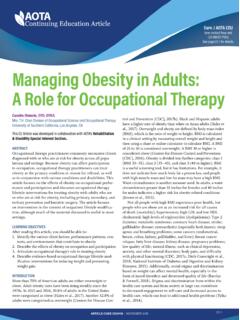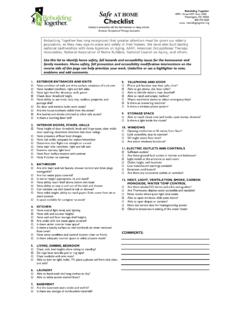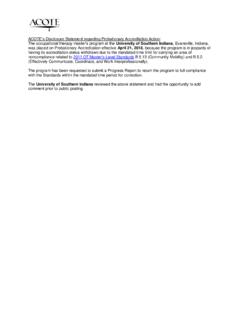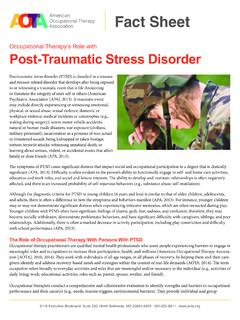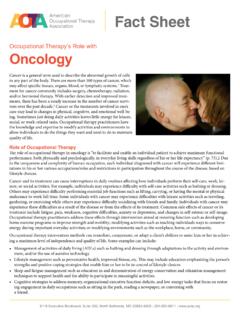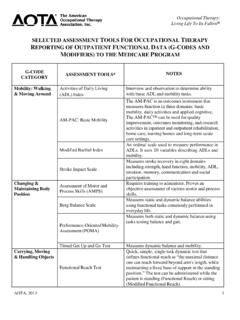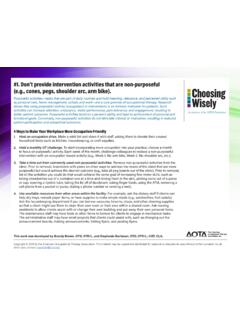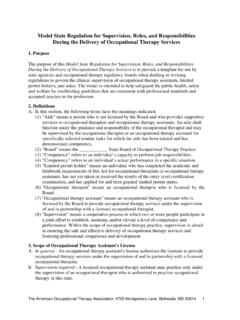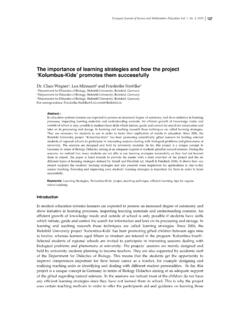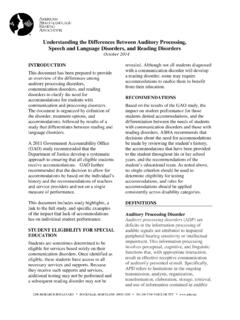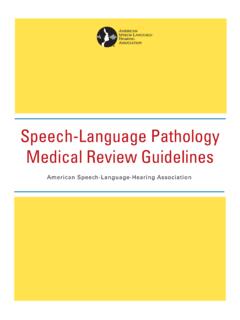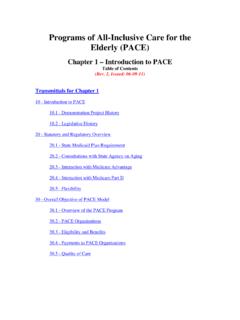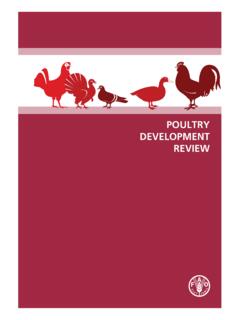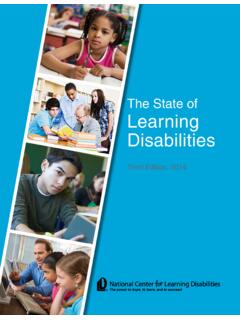Transcription of Pediatric Billing And Coding Tips And Tools
1 2020 by the American Occupational Therapy Association. This material may be copied and distributed for personal or educational uses without written consent. For all other uses, contact GuidelinesGood documentation is essential for proper reimbursement. Documentation should justify the medical necessity of the service while providing a clear picture of the client s limitations, goals, and functional outcomes. Below are a few general documentation guidelines and a wealth of AOTA resources that provide more detailed information. Document treatment time spent on each intervention. Document client-centered goals and outcomes. Document specialized skills needed to qualify as a skilled service.
2 link interventions to performance outcomes. Clearly state intervention approaches. Document the type of assessment used and the results of the assessment. Document clear recommendations and goals of continued Billing And CodingTips And ToolsContributions Made By:Cathy Brennan, MA, OTR/L, FAOTAB ryden Giving, MAOT, OTR/LTara Glennon, EDD, OTR/L, FAOTAK atie Jordan, OTD, OTR/LMary Walsh Sterup, OTR/LAlyson Stover, MOT, JD, OTR/L, BCP 2020 by the American Occupational Therapy Association. This material may be copied and distributed for personal or educational uses without written consent. For all other uses, contact ResourcesGuidelines for Documentation of Occupational Therapy for Maximizing Your Clinical Do s and Don ts of Documentation: Tips From OT How to be More Effective With Documentation: Q and A With Cathy Practice Documentation Tips: Save Time and Highlight OT s Distinct Pediatric Goals: How to Document Family Involvement & Developmental to Fix Common Early Intervention Documentation AOTA documentation resources can be accessed at Billing GuidelinesPayment for services varies by insurance carrier.
3 Refer to the Occupational Therapy Billing guidelines outlined by each individual insurance carrier. Be sure to investigate each carrier s particular requirements, including Coding , diagnosis, documentation, and referral. Some insurers develop coverage and Billing guidelines specifically based on a type of condition. Be sure to search under Occupational Therapy, Cognition, Sensory Integration, and/or Rehabilitation. Be aware of any specific insurance requirements regarding reconsiderations and appeals. Most insurers have time frames for sending appeals, and many have a form that must be completed. The appeal should include a cover letter (and/or specific required form) along with therapy records.
4 The focus of the appeal should present a clear reason why you feel the OT service should be payable. Be aware that the appeal requirements and time frames for one insurance company are likely to differ from other insurance companies with whom you work on behalf of other : Any procedure, and corresponding CPT code, can be deemed experimental/investigational or not be covered for other reasons by any insurance carrier. These procedures can be appealed to the insurance provider, and patients should be encouraged to fight the denial with their insurance company. If the intervention is not covered by the insurance carrier, it can be billed to the client. However, some insurance companies require that the patient be informed that the procedure is considered experimental/investigational or not covered prior to the procedure being performed and agree in writing to private pay for that procedure.
5 For this reason, investigating what is covered for each client s insurance plan is important prior to starting therapy services. Every state has an Insurance Commissioner who is tasked with monitoring insurance carriers for unfair practices. Filing a complaint with the Insurance Commissioner can be an effective last resort when an insurance carrier does not follow accepted standards for reimbursement. 2020 by the American Occupational Therapy Association. This material may be copied and distributed for personal or educational uses without written consent. For all other uses, contact Modifier UsageModifier 59 does not apply to all codes. Certain situations require the modifier to clarify that two services that would typically be considered part of the same service should both be allowed because in this instance they are performed as two separate and distinct to Remember: Modifier 59 should only be used when the two 15-minute timed services are performed sequentially.
6 The time spent must be clearly documented as separate and distinct, and cannot overlap. For example, if you spent 7 minutes on therapeutic activities and 10 minutes on self-care, only one 15-minute unit can be billed. But, if you spent 15 minutes on therapeutic activities and then an additional, separate 15 minutes on self-care, you would bill both codes and modifier 59 would be 8-Minute RuleThe 8-minute rule was devised by CMS to determine how to report billable units of timed services. Many insurances follow these guidelines. Use these guidelines for timed services only. If an untimed service is also billed the same day, do not count the time spent on the untimed service towards billable units.
7 The following chart documents how many minutes must be provided in order to bill the corresponding number of units. Note how 1 billable unit for a timed code must be at least 8 minutes, and it does not increase to a second billable unit until you have at least 8 minutes past the 15-minute mark. If more than one timed CPT code is billed during a calendar day, then the total treatment time determines the number of units Minutes per UnitBillable Minutes001-71158 2223023 3734538 5246053 67 Diagnosis Code SelectionThe treating diagnosis is not always the primary medical diagnosis. Use the diagnosis that most appropriately describes the condition you are treating. More than one diagnosis may be appropriate.
8 Do include any comorbidities that are affecting treatment. If possible, avoid unspecified codes. 2020 by the American Occupational Therapy Association. This material may be copied and distributed for personal or educational uses without written consent. For all other uses, contact Used Current Procedural Terminology (CPT ) CodesOCCUPATIONAL THERAPY EVALUATIONS97165 Occupational therapy evaluation, low complexity97166 Occupational therapy evaluation, moderate Occupational therapy evaluation, high complexity 97168 Occupational therapy re-evaluationTHERAPEUTIC PROCEDURES97110 Therapeutic procedure, one or more areas, each 15 minutes; therapeutic exercises to develop strength97112 Neuromuscular reeducation of movement, balance, coordination, kinesthetic sense, supervised posture, and/or proprioception for sitting and/or the application of a modality that does not require direct standing activities (one-on-one) patient contact97113 Aquatic therapy with therapeutic exercises97129 Therapeutic interventions that focus on cognitive function ( , attention, memory, reasoning, executive function, problem solving, and/or pragmatic functioning) and compensatory strategies to manage the performance of an activity ( , managing time or schedules, initiating, organizing, and sequencing tasks), direct (one-on-one) patient contact.
9 First 15 minutes 97130 Each additional 30 minutes (list separately in addition to code for primary procedure)97150 Therapeutic procedure, group (2 or more individuals) 97530 Therapeutic activities, direct (one-on-one) patient contact (use of dynamic activities to improve functional performance), each 15 minutes97533 Sensory integrative techniques to enhance sensory processing and promote adaptive responses to environmental demands, direct (one-on-one) patient contact, each 15 minutes97535 Self-care/home management training ( , activities of daily living [ADLs] and compensatory training, meal preparation, safety procedures, and instructions in use of assistive technology devices/adaptive equipment), direct one-on-one contact, each 15 minutesTESTS AND MEASUREMENTS95851 Range of motion measurements and report (separate procedure); each extremity (excluding hand) or each trunk section (spine)95852 Range of motion measurements and report (separate procedure).
10 Hand, with or without comparison to normal side97750 Physical performance test or measurement ( , musculoskeletal, functional capacity), with written report, each 15 minutes97755 Assistive technology assessment ( , to restore, augment, or compensate for existing function, optimize functional tasks and/or maximize environmental accessibility), direct one-on-one contact, with written report, each 15 minutesORTHOTIC MANAGEMENT AND TRAINING AND PROSTHETIC MANAGEMENT97760 Orthotic(s) management and training (including assessment and fitting when not otherwise reported), upper extremity(ies), lower extremity(ies) and/or trunk, initial orthotic(s) encounter, each 15 minutes97761 Prosthetic(s) training, upper and/or lower extremity(ies), initial prosthetic(s) encounter, each 15 minutes97763 Orthotic(s)/prosthetic(s) management and/or training, upper extremity(ies), lower extremity(ies), and/or trunk, subsequent orthotic(s)/prosthetic(s) encounter, each 15 minutesCENTRAL NERVOUS SYSTEM ASSESSMENTS/TESTS ( , NEURO-COGNITIVE, MENTAL STATUS, SPEECH TESTING)96110 Developmental screening ( , developmental 2020 by the American Occupational Therapy Association.)
